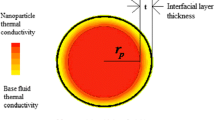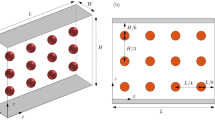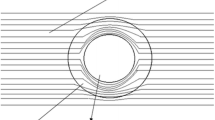Abstract
The interfacial layer of nanoparticles has been recently shown to have an effect on the thermal conductivity of nanofluids. There is, however, still no thermal conductivity model that includes the effects of temperature and nanoparticle size variations on the thickness and consequently on the thermal conductivity of the interfacial layer. In the present work, the stationary model developed by Leong et al. (J Nanopart Res 8:245–254, 2006) is initially modified to include the thermal dispersion effect due to the Brownian motion of nanoparticles. This model is called the ‘Leong et al.’s dynamic model’. However, the Leong et al.’s dynamic model over-predicts the thermal conductivity of nanofluids in the case of the flowing fluid. This suggests that the enhancement in the thermal conductivity of the flowing nanofluids due to the increase in temperature does not come from the thermal dispersion effect. It is more likely that the enhancement in heat transfer of the flowing nanofluids comes from the temperature-dependent interfacial layer effect. Therefore, the Leong et al.’s stationary model is again modified to include the effect of temperature variation on the thermal conductivity of the interfacial layer for different sizes of nanoparticles. This present model is then evaluated and compared with the other thermal conductivity models for the turbulent convective heat transfer in nanofluids along a uniformly heated tube. The results show that the present model is more general than the other models in the sense that it can predict both the temperature and the volume fraction dependence of the thermal conductivity of nanofluids for both non-flowing and flowing fluids. Also, it is found to be more accurate than the other models due to the inclusion of the effect of the temperature-dependent interfacial layer. In conclusion, the present model can accurately predict the changes in thermal conductivity of nanofluids due to the changes in volume fraction and temperature for various nanoparticle sizes.













Similar content being viewed by others
Abbreviations
- a :
-
Particle radius
- c :
-
Specific heat
- d :
-
Diameter
- h :
-
Interfacial layer thickness
- h f :
-
Averaged heat transfer coefficient of base fluid
- h nf :
-
Averaged heat transfer coefficient of nanofluid
- k :
-
Thermal conductivity
- k b :
-
Boltzmann’s constant
- k eff :
-
Effective thermal conductivity
- k static :
-
Effective stagnant thermal conductivity of solid–liquid mixture
- k V :
-
Enhancement in the thermal conductivity due to the thermal dispersion
- p :
-
Probability for a particle to travel along any direction
- u, v, w :
-
Velocity components in X, Y, Z Cartesian coordinates
- C :
-
Modified model constants
- T :
-
Temperature
- T ∞ :
-
Temperature at the infinite distance
- \( \left| {\bar{V}} \right| \) :
-
Averaged velocity
- γ :
-
Ratio of interfacial layer thickness to particle radius \( = \frac{h}{a} \)
- β :
-
Function in Leong et al.’s model (2006) = 1+g
- β 1 :
-
Function in Leong et al.’s model (2006)\( = 1 + \frac{\gamma }{2} \)
- ϕ :
-
Volume fraction of nanoparticles
- τ :
-
Shear stress
- ρ :
-
Density
- μ :
-
Viscosity
- f:
-
Base fluid
- lr:
-
Interfacial layer
- nf:
-
Nanofluid
- p:
-
Particle
References
Amiri A, Vafai K (1994) Analysis of dispersion effects and non-thermal equilibrium, non-Darcian, variable porosity, incompressible flow through porous media. Int J Heat Mass Transf 37:939–954
Buongiorno J (2006) Convective transport in nanofluids Transactions of the ASME. J Heat Transf 128:240–250
Chon CH, Kihm KD, Lee SP, Choi SUS (2005) Empirical correlation finding the role of temperature and particle size for nanofluid (Al2O3) thermal conductivity enhancement. Appl Phys Lett 87:153107(1–3)
Das SK, Putra N, Thiesen P, Roetzel W (2003) Temperature dependence of thermal conductivity enhancement for nanofluids Transactions of the ASME. J Heat Transf 125:567–574
Eastman JA, Choi SUS, Li S, Thompson LJ (1997) Enhanced thermal conductivity through the development of nanofluids. In: Proceedings of the symposium on nanophase and nanocomposite materials II, vol 457. Boston, pp 3–11
Eastman JA, Choi SUS, Li S, Yu W, Thompson LJ (2001) Anomalously increased effective thermal conductivities of ethylene glycol-based nanofluids containing copper nanoparticles. Appl Phys Lett 78(6):718–720
Eastman JA, Phillpot SR, Choi SUS, Keblinski P (2004) Thermal transport in nanofluids. Annu Rev Mater Res 34:219–246
Hamilton RL, Crosser OK (1962) Thermal conductivity of heterogeneous two-component systems. I&EC Fundam 1:187–191
Keblinski P, Phillpot SR, Choi SUS, Eastman JA (2002) Mechanism of heat flow in suspensions of nano-sized particles (nanofluids). Int J Heat Mass Transf 25:855–863
Khanafer K, Vafai K, Lightstone M (2003) Buoyancy-driven heat transfer enhancement in a two-dimensional enclosure utilizing nanofluids. Int J Heat Mass Transf 46:3639–3653
Koo J, Kleinstreuer C (2004) A new thermal conductivity model for nanofluids. J Nanopart Res 6:577–588
Kwak K, Kim C (2005) Viscosity and thermal conductivity of copper oxide nanofluid dispersed in ethylene glycol. Korea-Australia Rheol J 17(2):35–40
Lee S, Choi SUS, Li S, Eastman JA (1999) Measuring thermal conductivity of fluids containing oxide nanoparticles Transactions of the ASME. J Heat Transf 121:280–289
Leong KC, Yang C, Murshed SMS (2006) A model for the thermal conductivity of nanofluids—the effect of interfacial layer. J Nanopart Res 8:245–254
Li CH, Peterson GP (2006) Experimental investigation of temperature and volume fraction variations on the effective thermal conductivity of nanoparticle suspensions (nanofluids). J Appl Phys 99:084314(1–8)
Maïga SEB, Nguyen CT, Galanis N, Roy G (2004) Heat transfer behaviors of nanofluids in a uniformly heated tube. J Superlatt Microstruct 35:543–557
Masuda H, Ebata A, Teramae K, Hishinuma N (1993) Alteration of thermal conductivity and viscosity of liquid by dispersing ultra-fine particles. Netsu Bussei 7(4):227–233
Maxwell JC (1873) Electricity and magnetism. Clarendon Press, Oxford, UK
Pak BC, Cho Y (1998) Hydrodynamic and heat transfer study of dispersed fluids with submicron metallic oxide particles. Exp Heat Transf 11:151–170
Patal H, Das SK, Sundararajan T, Sreekumaran A, George B, Pradeep T (2003) Thermal conductivities of naked and monolayer protected metal nanoparticle based nanofluids: manifestation of anomalous enhancement and chemical effects. Appl Phys Lett 83(14):2931–2933
Wang BX, Zhou LP, Peng XF (2003) A fractal model for predicting the effective thermal conductivity of liquid with suspension of nanoparticles. Int J Heat Mass Transf 46:2665–2672
Xie H, Wang J, Xi T, Liu Y, Ai F (2002) Thermal conductivity enhancement of suspensions containing nanosized alumina particles. J Appl Phys 91:4568–4572
Xuan Y, Roetzel W (2000) Conceptions for heat transfer correlation of nanofluids. Int J Heat Mass Transf 43:3701–3707
Xue L, Keblinski P, Phillpot SR, Choi SUS, Eastman JA (2004) Effect of liquid layering at the liquid–solid interface on thermal transport. Int J Heat Mass Transf 47:4277–4284
Yu W, Choi SUS (2003) The role of interfacial layers in the enhanced thermal conductivity of nanofluids: a renovated Maxwell model. J Nanopart Res 5:167–171
Yu W, Choi SUS (2004) The role of interfacial layers in the enhanced thermal conductivity of nanofluids: a renovated Hamilton–Crosser model. J Nanopart Res 6:355–361
Acknowledgements
This research work is partly supported by the Thai National Grid Centre and the Sun Microsystems. The Financial supports from the Kasetsart University Research and Development Institute (KURDI) and the Thailand Research Fund (TRF) for the Senior Scholar Professor Pramote Dechaumphai and the Scholar Associate Professor Varangrat Juntasaro.
Author information
Authors and Affiliations
Corresponding author
Rights and permissions
About this article
Cite this article
Sitprasert, C., Dechaumphai, P. & Juntasaro, V. A thermal conductivity model for nanofluids including effect of the temperature-dependent interfacial layer. J Nanopart Res 11, 1465–1476 (2009). https://doi.org/10.1007/s11051-008-9535-4
Received:
Accepted:
Published:
Issue Date:
DOI: https://doi.org/10.1007/s11051-008-9535-4




